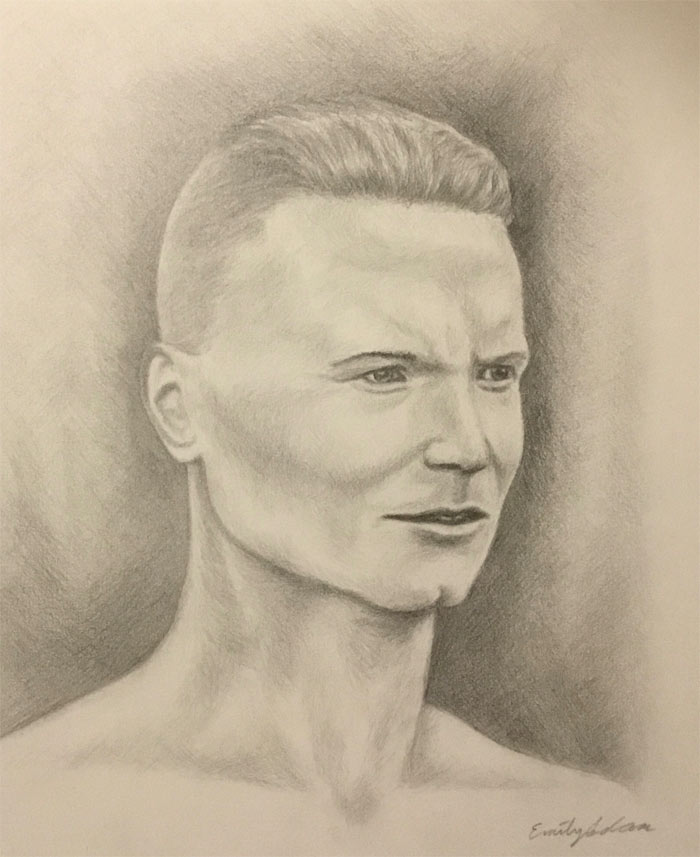Portrait by Emily, Drawing Academy student
I just enrolled in the Drawing Academy a few days ago, and I am already glad that I did. I have been drawing for most of my life, but I was quite amazed at the concepts and skills I have been learning here which are almost entirely new to me. I have read a little about the hatching and crosshatching techniques in years gone by, but I never actually employed them much in my own works. After learning more about them here, I decided to give it a try on a portrait. The subject was wearing a high collared tunic. I omitted this from the picture so that I’d have to fall back on my knowledge of form and anatomy to draw what I could not see. Keeping in mind the constructive drawing principles as I worked, I found that I was also able to capture a likeness more easily than I could before. But when I first tried the hatching method to render shades, I began to feel frustrated because it seemed I could not get the right feel for it. I then decided to just relax and not think too hard on using the right method, and pretty soon I found that it felt more natural to work in controlled strokes than to simply scribble as I had always done before. I was also happier with the results, this was my first attempt rendering shades on a portrait in this way. Can you tell me how can I improve this drawing?
Emily
Dear Emily,
Thank you very much for your wonderful portrait drawing. I really like your artwork, great job!
You are asking how to improve this portrait. Before rendering tonal values, you need to make sure the constructive drawing is correct. No rendering would fix constructive drawing mistakes.
One of common mistakes many artists make when drawing an ear is connecting the helix and tragus with one outline. The real anatomy is different. The helix outline goes down into the concha, while the tragus sits nearby. One of my friends once said: “If you would like to test an artist, ask to draw an ear from memory; this will separate amateurs from professionals.”
More than 500 years ago, Leonardo da Vinci left numerous notes in his sketchbooks about proportions of a human head. Here’s what can learn from this great master – the distance from an ear to the eyebrow is the same as the height of the ear. This dimension is also equal to the eyebrow’s width or the height of the nose.
In your drawing, the height of the ear is noticeably smaller than the distance from it to the eyebrow.
When it comes to rendering tonal values, you need to understand the purpose of this exercise. Many artists think that the sole purpose of rendering is depicting lights and shadows. As such the process turns into “decoration with values”. This results in mistakes and an artwork often looks flat. However, should you use tonal rendering as the way of constructive drawing, working on the object’s three-dimensional structure, it would give more convincing results. In such case, realistic tonal values will be a sub-product, not a purpose of rendering.
How to render tonal values the right way is a much greater topic than I can describe in one review. It consists of many things and requires various skills, including the knowledge of anatomy, understanding of contours, applying pencils strokes along contours, using good style of rendering and so on.
There are many special exercises we give to our students in the Life Drawing Academy Correspondence Course. These exercises develop the necessary skills of drawing realistic portraits and figures from life, memory and imagination. In this course, for a one-time fee, we provide one-to-one personal tutoring until a student achieves the advanced level of drawing skills.
To your creative success,
Vladimir London
Art tutor






Dear Vladimir,
Thank you for your feedback and advice. It really helped to clear things up. I kept thinking that the distance between the ear and the face in the portrait was a little too great, and I wasn’t quite sure how to correct that. Now I know how to improve it in the future.
Emily
Thank you very much for your article.
It is very helpful to understand the difference between constructive of anatomy and tonal rendering.
Thanks once again..